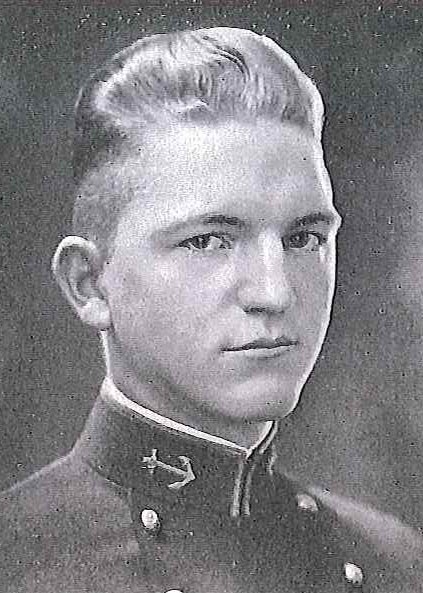Lowe Hayden Bibby was born on May 16, 1899, at Charleston, Mississippi, son of the late Dr. Lowe H. Bibby and Mrs. Bessie (Calhoun) Bibby. He was graduated from Grenada High School, Grenada, Mississippi and attended Millsaps College, Jackson, Mississippi, for year before his appointment to the US Naval Academy, Annapolis, Maryland, from his native state in 1918. Graduated and commissioned Ensign on June 2, 1922, he received progressive promotions until he attained the rank of Captain, to date from April 1, 1943.
Upon graduation from the Naval Academy in June 1922, he was assigned duty in USS Florida, a unit of Battleship Division 1, Scouting Fleet, and during the period 1923 he had further sea duty in the destroyer Breck, Overton and Williamson; and, after submarine instruction at the Submarine School, Newport, Rhode Island, in the submarines S-43 and S-25. He had shore duty from 1930 until 1932 as Officer in Charge of the Experimental Diving Unit, Navy Yard, Washington, DC.
He again had submarine duty (1932-1935) in successive command of USS S-4 and the USS S-43, after which he returned to Annapolis for a tour of duty as instructor in Electrical Engineering. In 1938-1939 he served on the staff of Commander, Submarine Squadron 5 operating between China and Manila, PI, and in 1940, commanded Submarine Division 10. He then became First Lieutenant of the cruiser USS August. He remained aboard the Augusta until 1943, participating in the Invasion of North Africa in November 1942, while serving as her Executive Officer.
Returning to the United States in the summer of 1943, he reported fro duty first as Commanding Officer of the Naval Training School (Officers’ Damage Control), and later as Commanding Officer of the Naval Damage Control Training Center, Philadelphia, Pennsylvania. He received a Letter of Commendation with authorization to wear the Commendation Ribbon from the Secretary of the Navy for services in that assignment.
Relieved of command of the Damage Control Training Center, he served as Deputy Chief Military Government Officer, on the staff of the Commanding General, Tenth Army, and later as Commanding Officer of the US Naval Military Government, Okinawa, Ryukyu Islands, from D-Day of Invasion of Okinawa, April 1, 1945, until October 1945. For exceptionally meritorious service in the two assignments, he was awarded the Legion of Merit with citation, in part, as follows:
“…..outstanding services to the Government of the United States as Deputy Chief Military Government Officer, Military Government Section, Headquarters, TENTH Army, and subsequently as Deputy Chief Military Government Section, Headquarters, TENTH Army, and subsequently as Deputy Chief Military Government Officer of Island, Command, Okinawa, Ryukyu Islands, November 25, 1944, to July 28, 1945…..(He) rendered invaluable service in the over- all planning, organization and supervision of activities on Okinawa and was responsible for the creation and efficient organization of sixty-one field units. In addition, he coordinated the separate responsibilities of the various commands charged with the procurement and transportation of personnel, supplies and equipment for his area, thereby expediting vital shipments from the Untied States…..”
Returning to the United States in November 1945, he was ordered to duty as Commanding Officer of USS Portland (CA 33), and in 1946 was transferred to command of USS New York (BB 34). For outstanding services as “Commanding Officer of the USS New York, a major target vessel of Joint Task Force One, during Operation Crossroads, from February to July 1946…..” he received a Letter of Commendation, with authorization to wear a bronze star on his Commendation Ribbon, from the Secretary of the Navy.
After completing the course at the National War College in May 1947, he was ordered to duty as Officer in Charge, War Plans Sub-Section in the Office of Strategic Plans, Office of the Chief of Naval Operations, Navy Department, Washington, DC. He served in that assignment until December 1948 when he was transferred to duty with the US Naval Mission to Brazil, at Rio de Janeiro. Detached in August 1950, he returned to the Office of the Chief of Naval Operations. In January 1951 he was designated Navy Liaison Officer, Office of the Chief of Army Ground Forces, Fort Monroe, Virginia.
In addition to the Legion of Merit and Commendation Ribbon with Bronze Star, Captain Bibby has the Victory Medal (World War I); the China Service Medal; the American Defense Service Medal with bronze “A;” the American Campaign Medal; the European-African-Middle Eastern Campaign Medal with one star; the Asiatic-Pacific Campaign Medal with one star; and the World War II Victory Medal.
He died June 4, 1968.





